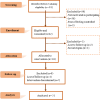Mobile Therapeutic Attention for Treatment-Resistant Schizophrenia (m-RESIST) Solution for Improving Clinical and Functional Outcomes in Treatment-Resistant Schizophrenia: Prospective, Multicenter Efficacy Study
- PMID: 40372941
- PMCID: PMC12140382
- DOI: 10.2196/67659
Mobile Therapeutic Attention for Treatment-Resistant Schizophrenia (m-RESIST) Solution for Improving Clinical and Functional Outcomes in Treatment-Resistant Schizophrenia: Prospective, Multicenter Efficacy Study
Abstract
Background: Treatment-resistant schizophrenia (TRS) is a severe form of schizophrenia associated with low adherence to treatment and poor outcomes. Mobile health (mHealth) interventions may be effective in preventing relapses, increasing treatment adherence, and managing some of the symptoms of schizophrenia. Mobile therapeutic attention for treatment-resistant schizophrenia (m-RESIST) is an innovative mHealth developed specifically for TRS.
Objective: We aim to evaluate the effects of m-RESIST on the clinical and functional outcomes and on the perceived quality of life in people with TRS.
Methods: A feasibility study without a control group was performed to test the m-RESIST solution on patients with TRS. Participants were recruited from Spain, Israel, and Hungary. This study's population (N=31) followed 3 months of intervention. The m-RESIST was configured by an app, a wearable, and a web-based platform. The severity of symptoms was evaluated by using the Positive and Negative Syndrome Scale (PANSS) and the Clinical Global Impression-Schizophrenia (CGI-SCH) scale. Functionality was assessed by the Global Assessment of Functioning and perceived quality of life was evaluated by the EuroQol visual analogue scale (EQ-VAS).
Results: Significant reductions were found in symptoms from pretrial to posttrial on the PANSS total (mean difference -7.2, 95% CI -11.1 to -3.4; P=.001), the PANSS positive (mean difference -1.36, 95% CI -2.6 to -0.1; P=.04), the PANSS negative (mean difference -2.1, 95% CI -3.1 to -1.1; P<.001), and the PANSS general symptoms (mean difference -3.8, 95% CI -6.8 to -0.8; P=.02). In almost one-fifth of the participants (6/31), the overall score for the PANSS decreased by more than 20%, which may be considered a clinically significant change. On the CGI-SCH scale, the sum of total severity of illness decreased significantly (P=.03). A decrease in the sum of positive and negative symptoms of the CGI-SCH score was also found (P=.04 and P=.03, respectively). The sum of depressive or cognitive symptoms did not change. The functionality of participants increased significantly on the Global Assessment of Functioning (P≤.001). The perceived quality of life on the EQ-VAS also improved (mean difference 6.7, 95% CI 0.5 to 12.9; P=.04).
Conclusions: To our best knowledge, this was the first study to address the efficacy of the mHealth app m-RESIST on the symptoms and functional capacity and on the quality of life for people with TRS. Our preliminary findings showed that implementing the m-RESIST solution decreased the symptoms and severity of disease, and improved the functionality and perceived quality of life among those with TRS. The change of symptoms on the PANSS total may be clinically significant. Modern technologies such as mHealth interventions may be useful in treating symptoms and functionality even in TRS, which is a major clinical challenge, with usually poor outcomes. These results should be corroborated by performing a controlled trial.
Keywords: treatment-resistant schizophrenia; application; digital health; feasibility study; m-RESIST; mHealth; mobile health; mobile phone; mobile therapeutic attention for treatment-resistant schizophrenia; psychosis.
© Jussi Seppälä, Eva Grasa, Anna Alonso-Solis, Alexandra Roldan-Bejarano, Marianne Haapea, Matti Isohanni, Jouko Miettunen, Johanna Caro Mendivelso, Cari Almazán, Katya Rubinstein, Asaf Caspi, Zolt Unoka, Kinga Farkas, Elisenda Reixach, Jesus Berdun, Judith Usall, Susana Ochoa, Iluminada Corripio, Erika Jääskeläinen, m-Resist Group. Originally published in JMIR Human Factors (https://humanfactors.jmir.org).
Conflict of interest statement
Figures
References
Publication types
MeSH terms
LinkOut - more resources
Full Text Sources
Miscellaneous


